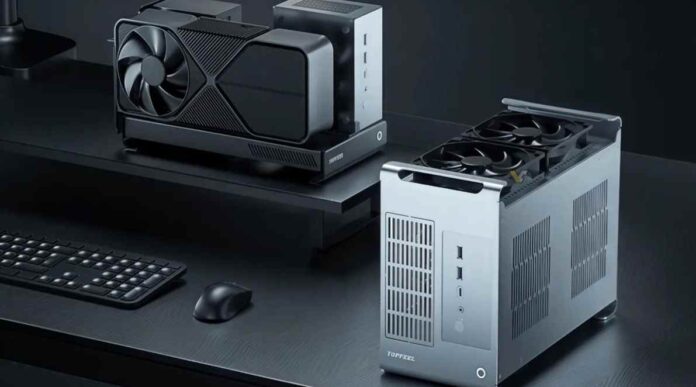- Topfeel’s new G1 and G1 Pro docks combine space for both a GPU and a mini PC in one unit
- They use OCulink interface for high speed and power both the mini PC and GPU via a shared supply
- G1 is open frame and affordable; G1 Pro is enclosed and built for better cooling
- Preorders are live in China; global availability and practical performance are still uncertain
Chinese company Topfeel, already making waves with its unconventional name, has just launched two new products that blur the line between mini PCs and external graphics docks.
Called the Topfeel G1 and Topfeel G1 Pro, these units are not just ordinary eGPU docks. They support both a full GPU and a mini PC in one single box. The goal: shrink a desktop-level setup into a compact, high-performance system. The concept sounds odd. But it might just work.
Rather than acting as a passive expansion box, Topfeel’s designs bring integration. The G1 and G1 Pro can physically hold both a desktop graphics card and a mini computer inside the same cage.
This approach means you no longer need separate towers. You no longer even need a classic desktop chassis. These docks are intended to consolidate everything while preserving full GPU performance.
Uses OCulink to Maintain Real GPU Speed
One major concern in external GPU setups is bandwidth loss. Many solutions rely on proprietary connectors or interfaces that throttle performance. Topfeel avoids that by using OCulink, a modern interface that offers PCIe 4.0 x4 speeds. This ensures the GPU runs close to native desktop speeds. In other words, you are not trading much performance for compactness.
Both models power the GPU and the mini PC from a shared internal power supply. This simplifies wiring and reduces external clutter. Topfeel calls this a unified power system. You plug in one power cable and get both computing and graphics.
G1: Open Design Meant for Experimenters
The standard G1 model is built with a more open frame. It exposes major components for easier access and quick swaps. Want to swap the GPU later? You can reach it easily. Topfeel also integrated slots for storage drives — you can mount up to two 2.5-inch SATA drives inside the same enclosure. The price is surprisingly modest: the base G1 costs around $82, while the version bundled with a 600 W power supply goes for about $137.
Despite its lower cost, the G1 is not short on ambition. The open design helps with cooling and flexibility. It may appeal to tinkerers, modders, and those who like to upgrade piece by piece.
G1 Pro: Enclosed, Cooler, More Refined
The G1 Pro moves in a more conventional direction. Its chassis is fully enclosed and supports mounting for up to two 120 mm fans. The improved airflow design aims to keep both the GPU and mini PC cool under load. The internal structure is more refined. The Pro variant also retains the dual-storage support. Pricing for the G1 Pro is roughly $109 for the bare dock, and $165 when bundled with the PSU.
While the Pro loses the open-frame flair, it gains better thermals and a cleaner aesthetic. For users who prefer something that looks like a polished peripheral rather than a hacky rig, the Pro may be more appealing.
Why Topfeel Is Betting Big on This Hybrid Idea
Mini PCs have advanced rapidly. Many can now run everyday tasks and basic gaming. But they struggle when it comes to heavy GPU workloads. Traditional eGPU setups allow you to plug a GPU into a mini PC—but only externally. Topfeel’s solution places everything under one roof. It effectively transforms a stripped-down PC into a potent workstation without needing a full desktop tower.
By combining the mini PC and GPU in one docking solution, Topfeel challenges the need for full-size desktops in certain use cases. Content creators, designers, and developers who use heavy graphics workloads could adapt to a setup like this. It offers portability and compactness without sacrificing power.
Challenges Ahead: Thermal, Compatibility, and Reliability
Despite the bold design, the concept must overcome significant hurdles. Cooling is perhaps the biggest concern. GPUs generate a lot of heat. Packing one alongside a mini PC — in a tight space — demands smart airflow design. The Pro model’s fan mounts help, but real-world tests will be critical.
Compatibility is another question. Not all mini PCs may perfectly fit or route power the way Topfeel intends. The power draw of high-end GPUs might stress the shared power system. And noise under load could be a downside.
There is also the issue of market confidence. Topfeel’s quirky name makes it memorable. But a name alone does not assure durability or support. The early prices are attractive. But preorders are currently limited to China. Some reported that the product pages are not loading reliably on Topfeel’s website. That raises questions about production readiness.
Still, the idea is compelling. If Topfeel nails cooling, compatibility, and reliability, its G1 and G1 Pro could find a niche. They might appeal to creators, small-office users, and space-conscious enthusiasts who want serious GPU power without a giant tower looming beside them.
Early Availability, Preorder Status, and Hurdles
As of now, the G1 and G1 Pro are available for preorder in China. International availability has yet to be confirmed. Some buyers report that the company’s site is down or that product pages fail to load. That may hint at supply challenges or an overwhelmed server.
Topfeel’s pricing approach is aggressive. Offering such hybrid docks at under $150 in many configurations is audacious. It indicates that the company is aiming to capture early adopters rather than premium margins.
It is unclear at the moment which mini PCs will work seamlessly inside these docks. Topfeel likely has design limits in terms of size, power tolerance, and physical layout. Fixtures, cable routing, and airflow will define how practical the end result will be.
Follow TechBSB For More Updates

